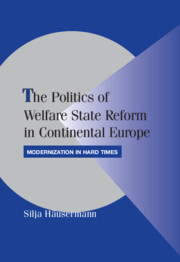Book contents
- Frontmatter
- Contents
- List of Figures
- List of Tables
- Preface
- The Politics of Welfare State Reform in Continental Europe
- 1 “EPPUR SI MUOVE”: WELFARE STATE CHANGE DESPITE INSTITUTIONAL INERTIA
- 2 MODERNIZATION IN HARD TIMES: THE POST-INDUSTRIAL POLITICS OF CONTINENTAL WELFARE STATE REFORM
- Part I Pension Reform in Continental Europe: A Framework of Analysis
- Part II Determinants of Successful Pension Reform in Continental Europe
- Appendices
- References
- Index
- Cambridge Studies in Comparative Politics
2 - MODERNIZATION IN HARD TIMES: THE POST-INDUSTRIAL POLITICS OF CONTINENTAL WELFARE STATE REFORM
Published online by Cambridge University Press: 06 July 2010
- Frontmatter
- Contents
- List of Figures
- List of Tables
- Preface
- The Politics of Welfare State Reform in Continental Europe
- 1 “EPPUR SI MUOVE”: WELFARE STATE CHANGE DESPITE INSTITUTIONAL INERTIA
- 2 MODERNIZATION IN HARD TIMES: THE POST-INDUSTRIAL POLITICS OF CONTINENTAL WELFARE STATE REFORM
- Part I Pension Reform in Continental Europe: A Framework of Analysis
- Part II Determinants of Successful Pension Reform in Continental Europe
- Appendices
- References
- Index
- Cambridge Studies in Comparative Politics
Summary
This chapter develops a coalition-centered theoretical framework for the analysis of continental welfare state change in a post-industrial context. The question is whether, why, and how structural challenges lead to policy reform. In other words, if the structural context changes and existing institutions become problematic or dysfunctional, what are the mechanisms that lead to policy adaptations? And what are the chances of these adaptations occurring?
The literature agrees that all western welfare states have been facing tremendous structural challenges in recent decades, in terms of both financial austerity and new social needs (see, e.g., Pierson 1996, 2001; Esping-Andersen 1999; Scharpf and Schmidt 2000; Bonoli, George, and Taylor-Gooby 2000; Huber and Stephens 2001). But there is no agreement as to how welfare states change in response to such challenges. Are they dismantled, preserved, or even restructured? In part, the inconclusive evidence with regard to the magnitude and direction of change is a result of the inherent difficulties of researching a moving target (i.e., the challenge of observing a trend still very much in progress). It is also a result of the fact that different welfare regimes develop in different directions. Structural challenges are filtered through the lenses of national politics and institutions. Hence, the same challenges produce different results in different countries (Pierson 2001, 2004; Scharpf and Schmidt 2000). But the literature on welfare state change also remains somewhat inconclusive, because different studies focus on different explanations and drivers of change.
- Type
- Chapter
- Information
- The Politics of Welfare State Reform in Continental EuropeModernization in Hard Times, pp. 14 - 30Publisher: Cambridge University PressPrint publication year: 2010

